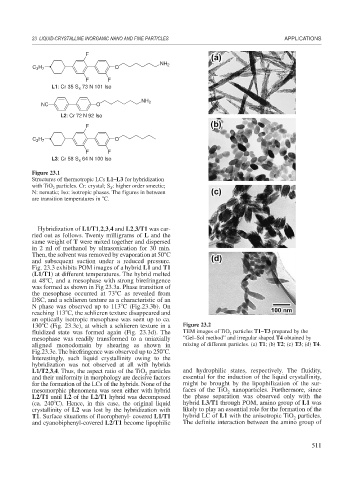Page 539 - Book Hosokawa Nanoparticle Technology Handbook
P. 539
23 LIQUID-CRYSTALLINE INORGANIC NANO AND FINE PARTICLES APPLICATIONS
F
NH 2
C 3 H 7 O
F F
L1: Cr 35 S 73 N 101 Iso
x
NH 2
NC O
L2: Cr 72 N 92 Iso
F
C 3 H 7 O
F F
L3: Cr 58 S 64 N 100 Iso
x
Figure 23.1
Structures of thermotropic LCs L1–L3 for hybridization
with TiO particles. Cr: crystal; S : higher order smectic;
X
2
N: nematic; Iso: isotropic phases. The figures in between
are transition temperatures in C.
Hybridization of L1/T1,2,3,4 and L2,3/T1 was car-
ried out as follows. Twenty milligrams of L and the
same weight of T were mixed together and dispersed
in 2 ml of methanol by ultrasonication for 30 min.
Then, the solvent was removed by evaporation at 50 C
and subsequent suction under a reduced pressure.
Fig. 23.3 exhibits POM images of a hybrid L1 and T1
(L1/T1) at different temperatures. The hybrid melted
at 48 C, and a mesophase with strong birefringence
was formed as shown in Fig 23.3a. Phase transition of
the mesophase occurred at 73 C as revealed from
DSC, and a schlieren texture as a characteristic of an
N phase was observed up to 113 C (Fig.23.3b). On
reaching 113 C, the schlieren texture disappeared and
an optically isotropic mesophase was seen up to ca.
130 C (Fig. 23.3c), at which a schlieren texture in a Figure 23.2
fluidized state was formed again (Fig. 23.3d). The TEM images of TiO particles T1–T3 prepared by the
2
mesophase was readily transformed to a uniaxially “Gel–Sol method” and irregular shaped T4 obtained by
aligned monodomain by shearing as shown in mixing of different particles. (a) T1; (b) T2; (c) T3; (d) T4.
Fig.23.3e. The birefringence was observed up to 250 C.
Interestingly, such liquid crystallinity owing to the
hybridization was not observed at all with hybrids
L1/T2,3,4. Thus, the aspect ratio of the TiO particles and hydrophilic states, respectively. The fluidity,
2
and their uniformity in morphology are decisive factors essential for the induction of the liquid crystallinity,
for the formation of the LCs of the hybrids. None of the might be brought by the lipophilization of the sur-
mesomorphic phenomena was seen either with hybrid faces of the TiO nanoparticles. Furthermore, since
2
L2/T1 until L2 of the L2/T1 hybrid was decomposed the phase separation was observed only with the
(ca. 240 C). Hence, in this case, the original liquid hybrid L3/T1 through POM, amino group of L1 was
crystallinity of L2 was lost by the hybridization with likely to play an essential role for the formation of the
T1. Surface situations of fluorophenyl- covered L1/T1 hybrid LC of L1 with the anisotropic TiO particles.
2
and cyanobiphenyl-covered L2/T1 become lipophilic The definite interaction between the amino group of
511

